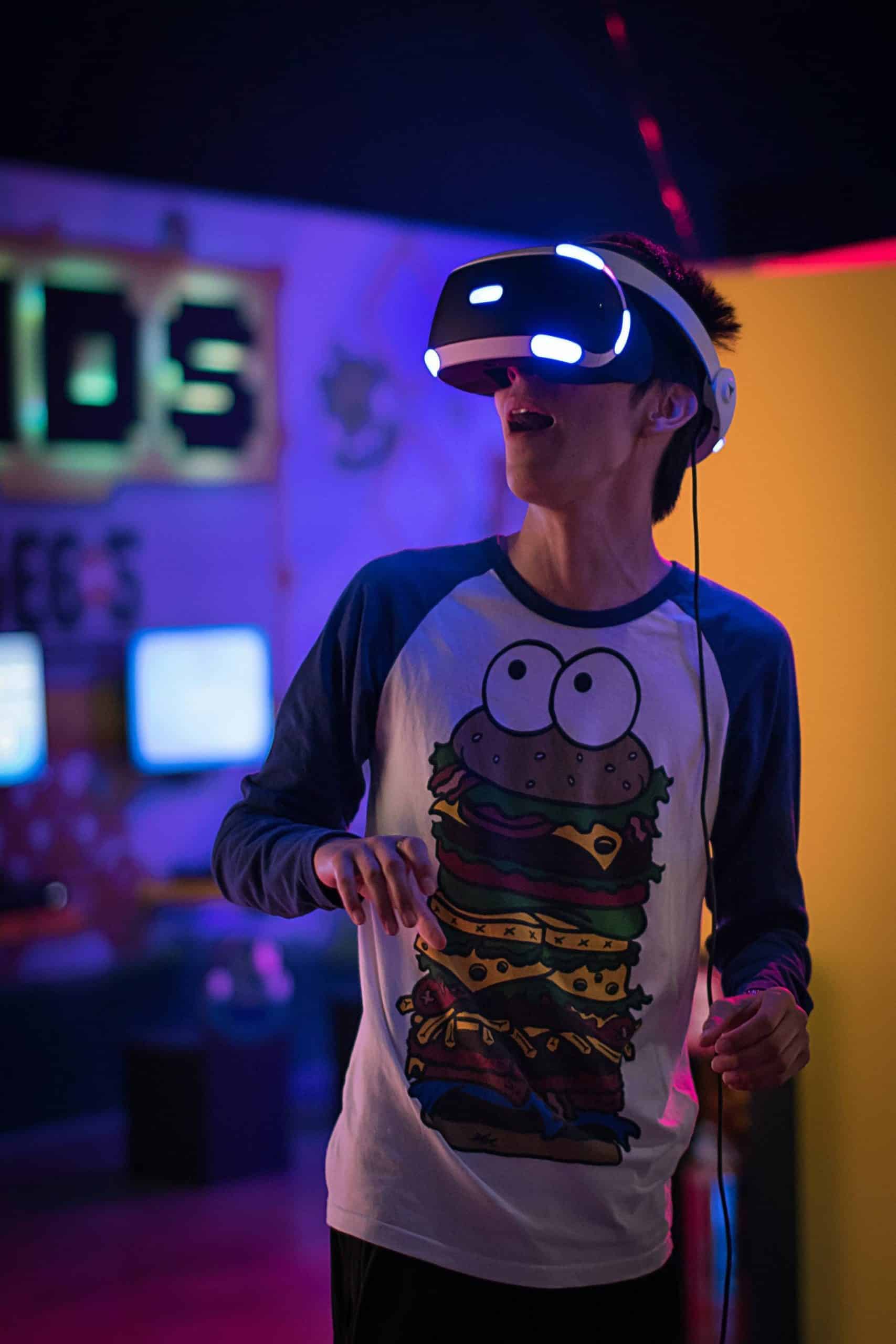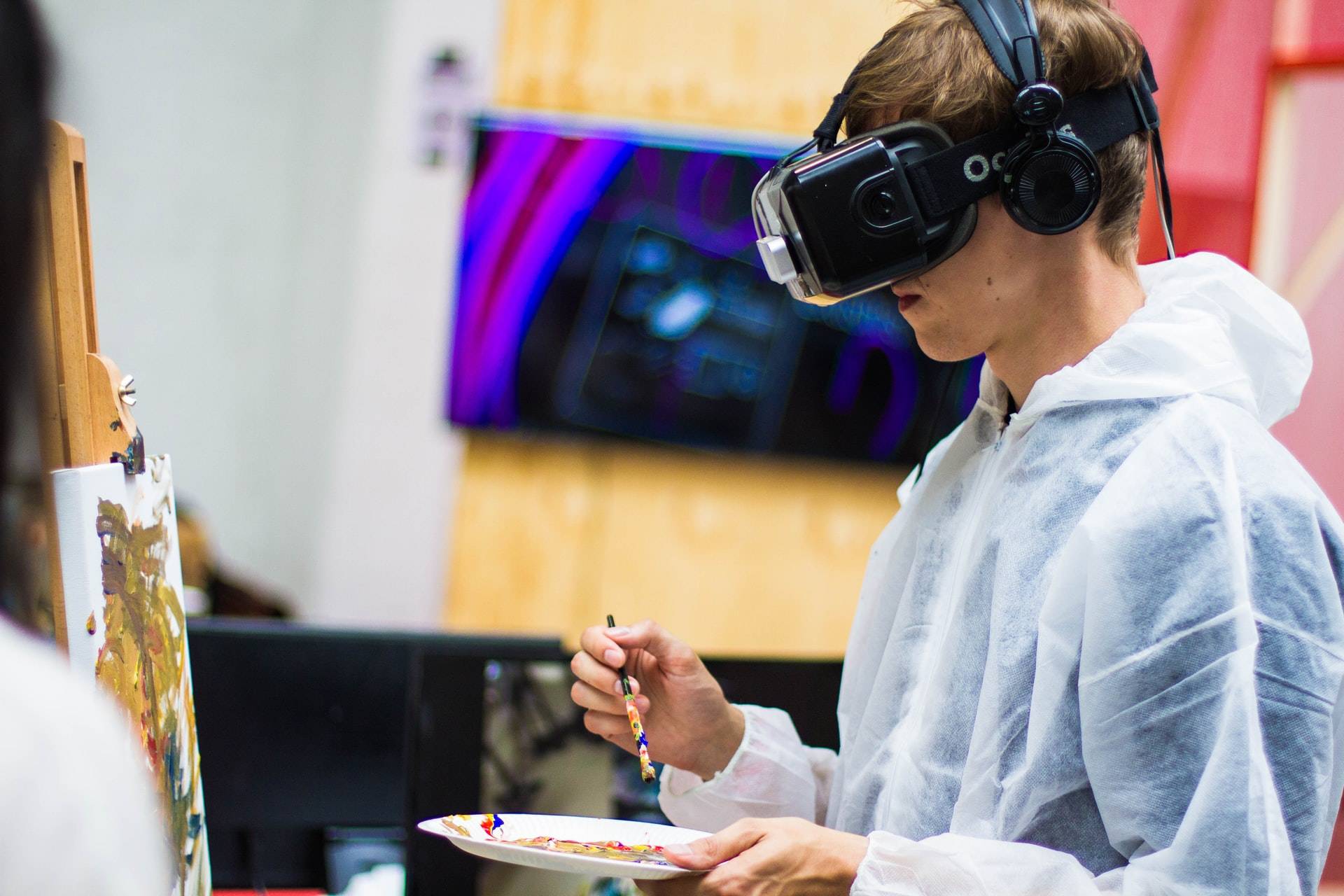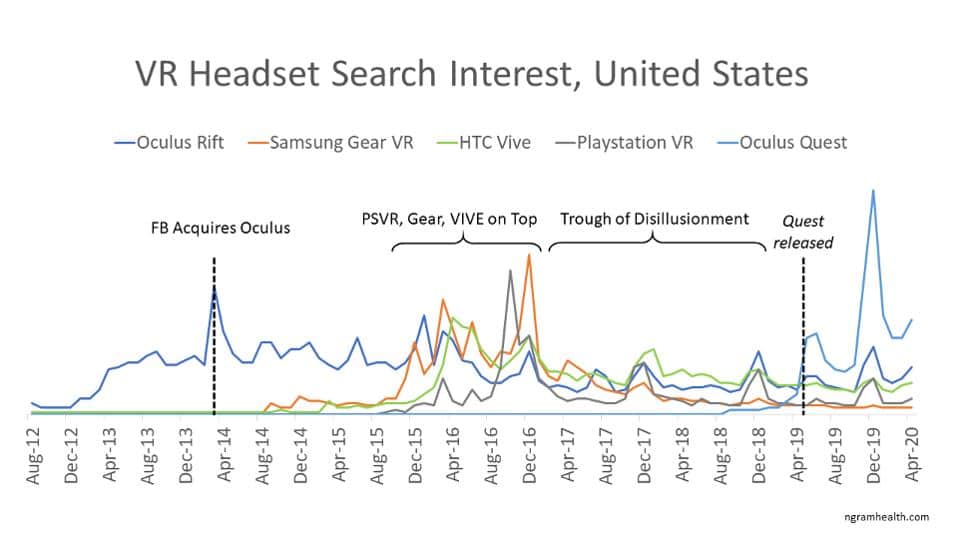Virtual Reality Business Ideas
By making any situation come alive anywhere one wants, VR is all set to unleash a wave of entrepreneurial energy.
The first step in starting a Virtual Reality business is to identify your business idea.
What concept are you going to use to set up your VR business?
Think ‘Virtual Reality’, and what comes to mind?
- Pilot the USS Enterprise.
- Walk among dinosaurs, maybe even get to slide down the neck of a brontosaurus.
Something along those lines, right?
In other words, you’re thinking of VR experiences, or games, like people can experience at an arcade.
That’s a sound business idea.
From the arcade’s point of view, they’ll be struggling to manage booking requests, as long as there are Star Wars and Jurassic Park fans around (which is forever, right?).
That being said, fantasy-based adventures are not the only scope for VR business opportunities.
Let’s dig a little deeper, and take up another situation in order to understand the potential that virtual reality holds to generate business opportunities.
How can the concept of virtual reality add value to an experience?
Like almost every restaurant in the world, the La Petite Maison in Dubai was hit hard by the coronavirus crisis.

The inevitable lockdown made revenue disappear overnight.
So, what do you think they did?
Like most restaurants, they shifted to the home delivery model.
Common sense precautions (like fast perishing food items being removed from the menu) were taken, and a tie-up with Deliveroo done, to implement home delivery.
So far, no good, right?
I mean, shifting to home delivery, tying up with a food delivery business, taking the necessary precautions - these are all staple advice, right? Most restaurants worth their salt are doing this.
Wait; I haven’t revealed the clinching factor yet.
Wait; I haven’t revealed the clinching factor yet.
Where La Petite Maison went above and beyond was in thinking up how to offer their customers more value.
The restaurant included its trademark table décor – a bottle of olive oil, lemon, and a freshly-baked baguette - in a specially hand-printed bag with every order.
And, a playlist on Spotify (called ‘LPM – La Vie en Rose’, if you’re interested) was made available.
These were done to simulate the ‘full La Petite Maison expérience’.
And it’s a pretty popular and successful strategy.
Now, what was the point of discussing this?
Making people believe that they are in a different situation...
Believe it or not, that experiment of the restaurant is a rudimentary example of virtual reality.

Think about it.
The table decor added by the restaurant offers visual, olfactory and gustatory (sense of taste) triggers to people, to simulate the experience of actually being at the restaurant.
That boosts the value of the product (the restaurant’s food delivery).
Does this give you an idea of the massive business potential VR holds?
Not limited to ‘living the dream’
This example shows the potential in one paradigm - enabling people to live their dream.
Once you start including other paradigms - like using sensory inputs to simulate an event that would be dangerous in the real world (like a plane crash; VR used to train pilots) - the business potential expands multifold.
And this is just core VR.
As virtual reality expands, and the industry gains importance, there will be business opportunities in ancillary fields; more on this in a while.
VR business ideas
The point that I’m trying to drive home is that as of 2020, VR has two characteristics that make it an excellent industry in which to start a business.
- It’s poised to experience explosive growth (as we’ll see in a second).
- It’ll create a massive ecosystem of its own, where there are business opportunities galore.
The business potential of VR

A report by the International Data Corporation forecasts global spending on VR (and AR, Augmented Reality) to grow at a CAGR (compound annual growth rate) of 77% from 2019 to 2023.
In absolute terms, the VR market is estimated to reach $120 billion by 2026.
Business ideas in the Virtual Reality ecosystem
The VR ecosystem spans multiple sectors - from entertainment to healthcare to education.
Depending on the kind of service you provide, there are 3 broad categories of VR businesses:
Arena-based VR businesses

The idea is that you rent a space with a view to creating a VR experience that people (your customers) can enjoy.
The basic process behind starting these kinds of businesses is:
- Select a premises - Since you’ll be expecting people to come to your business premises, you may find it convenient to look for premises in a high-footfall area. Depending on your niche, you should look at malls, tourist hotspots, or business districts.
- Plan a library of content - Study your target client, and plan a library of content that they’ll like. The content can range from straightforward games to virtual tours, and even to concerts and sporting events.
- Acquire your VR gear - You will need to acquire both hardware and software.
- If you’re just starting out, planning your content library and acquiring VR hardware and software can prove difficult. A VR franchise will be able help you out, since they have studied the market and know what is in demand.
- Train your staff - You won’t require a lot of manpower, but they will need to be trained to oversee the sessions in progress, intervene if necessary, and reset and clean the equipment between sessions.
- Cleaning the VR equipment, especially the headsets, between sessions is very important. More on this later.
VR escape rooms
Players experience zero-gravity flight, shoot lasers, fight against hostile robots, and use telekinesis, all while collaboratively solving puzzles and working to save Earth.
That’s an actual VR escape game; one where players do get to experience fighting with killer robots, shooting lasers, and so on.
All that while remaining seated within a 170 sq. ft. room.
If you think about it, that scores above a traditional escape room in a number of respects:
- It reduces staffing requirements, for example, one game master can take charge of multiple groups.
- It reduces the floor area each escape team needs, boosting your space efficiency.
- It vastly increases the kinds of experiences you can offer; for example recreating killer robots would be very difficult in a traditional escape room. In particular, players will be able to experience sensations like wind, heat, vibrations, and scents - that feature is built into the game.
On the other hand, it has all the features people look for in an escape room experience, like:
- It’s a group event.
- It can help with team building.
- It’s a thrilling experience; one that will make for a delightful afternoon.
- It’s appropriate for a wide range of occasions, like engagements, birthday parties, school outings, and so on.
So, in addition to regular bookings, you can offer packages for groups to celebrate special occasions at your VR escape room.
VR gaming/VR arcade
Remember the good old video game arcades in the ‘90’s?
Well, swap video games with VR, and you’ve got your second VR business idea - VR arcades.
In a VR arcade, VR terminals are placed one after another, and players can rent a terminal for one or more time slots.
Generally, the business model involves every terminal containing a menu of all the games that you have. Players can choose to play any game they want.
If you go for a VR arcade, though, you have to be careful to keep enough space between successive terminals for players to be able to move their hands around (which is typical to these kinds of games).
With the right game selection, you can soon expect a steady stream of bookings at your VR arcade.
VR events venue

If you can get a venue in a metropolitan area, especially within the financial district, you stand a good chance of being able to market yourself as a VR event venue.
From corporate shindigs to public fundraisers to private parties; there’s always tremendous scope in renting out your premises for VR events.
Please note here that different clients will have different requirements - and you’ll be expected to be able to accommodate them all.
For example, typically, companies will have their own content, while you will be expected to provide a plug and play type facility, that is, they will plug their content into your systems and be able to play it seamlessly.
On the other hand, with private parties, you may be expected to provide the content - games, tours, concerts, and so on.
To sum up, while a VR events venue business can be highly lucrative (because you’ll be hosting corporate and high end private events), it will require a high initial investment, to amass the VR software and the content library that your clients will demand.
VR dating
Had Nat King Cole been alive today, he would have sung ‘VR is very, very/Extra Ordinary..’.
While apps like Tinder may have solved the problem of connecting people, there’s still veracity to be reckoned for.
Surveys show high dissatisfaction with dating sites and apps - 2 in 5 people report negative experiences, with close to 1 in 10 people reporting very negative experiences.
One of the reasons for this high dissatisfaction rate would be people lying about something on their online profile.
If only there were a way to experience being in the same room as your date without actually being in the same room with them…
Enter VR dating, wherein people can meet in the same virtual space, which is the closest we can get to an intimate meeting with someone without actually being in the same room with them.
This isn’t as crazy as it sounds, even as you read this, there are companies engaged in providing VR dating services.
With covid-19 and the requirement for physical distancing, VR may well become the future of finding love.
VR service/content provider for other businesses
Many traditional organizations and businesses might want to introduce VR content into their product mix; they might outsource this to an outside business...which is where you come in.
Main pro - The XR (Extended Reality) Industry Report for 2019-2020 reported that
- 73% of companies surveyed said that they were working on VR for enterprise functions.
- 93% of enterprises reported VR to have a positive impact on their business.
Making this a sunshine sector.
Main con - Most enterprise customers will have very specific and complicated project requirements, which means you will need advanced skills to meet that demand.
Otherwise, you will cater to a smaller subset of the enterprises who’re looking for VR products/services.
VR in healthcare
One of the most impactful uses of VR in healthcare is Stanford University’s ‘room with a view’.
A view inside an infant’s beating heart.
A room-size visualization of a heart, in 3 dimensions.
After checking it out, this is what a doctor had to say:
I can literally see where the blood’s coming from and where it’s going in a way that I never had…
VR programs have been developed that allow a doctor, with the help of a headset and a controller, to check out different kinds of hearts, including those with defects.
Doctors can actually feel the blood flow, and even be ‘teleported’ inside the heart, so they are able to study it from the inside, providing crucial information that can prove invaluable in planning and executing surgical procedures.
There are 4 key advantages that VR presents here:
- Standing inside the heart, and observing things like blood flow are near impossible to do in real life.
- It reduces the need for acquisition and storage of real heart specimens, both of which are difficult.
- It can provide invaluable information for real life medical procedures.
- It can even help with diagnosing and treating mental health issues.
Working on such projects will typically require highly specialized VR development skills, though.
VR museums
Museums around the world are shaking up their business models, and innovating to meet heightened customer expectations.
VR fits very well into this.
Mona Lisa: Beyond the Glass
The famous painting by Leonardo da Vinci is extremely popular, with fans thronging to catch a glimpse of it every day.
Unfortunately, this also means:
- It’s impossible to enjoy the masterpiece in peace and quiet.
- The painting itself has to be kept out of reach of onlookers, to prevent it from getting damaged.
Enter Mona Lisa: Beyond the Glass, a project that VIVE Arts took up with the Louvre.
It allowed visitors to experience the Mona Lisa up close and personal, in complete solitude, and also allowed them to explore the painting like never before, including things like texture and a visualization of how the painting has aged over the years.
Useful features of VR museum tours
- They increase accessibility of artefacts to the public, particularly the differently abled.
- They boost public interest in the museum’s displays.
- They can give visitors an experience a real life museum can’t, like a virtual walk through da Vinci’s Rome.
VR equipment-based services
With the proliferation of VR into so many aspects of our lives, the demand for VR equipment is bound to rise.
For example, a 2019 report by Grand View Research forecast a 21.5% CAGR (Compound Annual Growth Rate) in demand for VR headsets between 2019 and 2025, culminating in a nearly $20 billion industry.
You can tap this demand by setting up a business related to VR equipment.
Two business ideas that immediately suggest themselves are:
- VR equipment supplier - You can either rent or sell VR hardware to end users.
VR hardware repairs - You can start up a third party/independent repair business for VR headsets and other hardware. iFixit is a good example of this kind of business.
VR content creation
There are two basic types of VR content, depending on what kind of content you want to create:
- 360 degree videos which, as the name suggests, creates an immersive, virtual version of a real world experience.
- 3D animation in VR, in which you create content that will appeal to VR consumers.
360 degree videos
Typically, such videos are made by shooting real-world footage with equipment like a spherical camera or a drone, and then using specialized software to edit the footage and create the 360 degree effect.
Such content would be used in situations like:
- Travel companies giving people a simulation of their tour packages (we will revisit this later).
- Hotels giving potential customers a feel of the hotel before they make a booking, and so on.
3D animation in VR
3D animation enables the viewer to move about and even interact with objects in the animation.
3D animation content would be useful in gaming and training scenarios.
VR community-based projects
The 3rd category of business ideas in the Virtual Reality ecosystem is based on organizing around the VR community.
You provide consulting and organizational assistance to the VR community.
VR consultancy

- What kind of VR business idea would be suitable for someone who wants to enter the industry?
- If they want to open an entertainment center, should they build an independent brand, or go for the franchise model?
- They may already have a VR content creation business, but they want some advice on what kind of content they should work on next.
If you’re experienced in VR, you may be able to consult with other VR businesses, providing them with strategic advice.
VR influencer
You can become an online influencer, in VR products and services.
You need to start off by building a VR community of your own.
Once you’ve established yourself, you can organize events discussing, celebrating and promoting VR.
Impact of covid-19 on Virtual Reality

Till now, we’ve gone over the various ways business opportunities may be found in the VR ecosystem.
It’s finally time to address the elephant in the room - covid-19.
What impact will covid-19 have on the Virtual Reality industry?
Impact of covid-19 on the overall economy
The coronavirus pandemic necessitated brutal across-the-board lockdowns to limit the spreading of the virus, sparking fears of a recession.
A recession would lead to lower discretionary spending by consumers, and a pullback on investments by enterprises, which would weigh down VR industry growth.
However, the latest reports suggest that economic growth has bottomed out and unemployment has peaked, which means we can expect a rebound in both discretionary spending by consumers, and investment in new projects (including VR) by businesses.
How will covid-19 impact the growth of the Virtual Reality industry?
Intuitively, we may make an informed guess that with people being discouraged from going out, going virtual will fill in the gap.
The immersion that VR provides can enhance the quality of limited physical interactions.
For example, the next best thing to a visit to Disney World would be a VR simulation of a visit to Disney World.
A VR team meeting can prove more effective at inspiring team spirit than video-conferencing.
However, these are guesswork, and anecdotal examples.
Let’s look at the facts, beginning with the level of interest for VR in the United States over the years.
Search interest for VR in the United States
Seeing that VR headsets have only one purpose - enabling the user to experience VR - we may take interest in VR headsets as a proxy for interest (and demand) for VR.

As you can see, when the various lockdowns started being enforced, interest in VR headsets grew immensely...even more so than when Facebook acquired Oculus (which was a pretty major event in the history of VR).
The ‘Trough of disappointment’ referred to in the image was a time in which content creation was failing to match expectations (headset prices were an issue too).
Content selection can play an outsize role in the success of consumer-facing VR ventures like a VR escape room.
Having identified a major uptick in interest in VR, the next question is, is this a one-off spark, or will the rise in interest, and demand, for VR sustain?
Niche-wise future outlook for VR
Depending on the kind of function it serves, VR use may be divided into 3 niches:
- Enterprise use
- Research
- Commercial/non-research use
- Non-enterprise/Consumer use
Let’s look at the outlook for VR in each of these, one by one.
Enterprise use - research
A good example of this kind of use would be the Stanford University VR visualization of a heart we saw earlier.
NASA has been using VR in its research of black holes.
By enabling research topics to come alive (well, virtually), VR is helping researchers unlock stages of research that would have been virtually unattainable earlier.
For example, the visualization of what goes on inside a heart could reveal ways of making surgical procedures safer.
We can safely say that this kind of VR application will only increase, covid-19 or no covid-19.
Enterprise use - commercial/non-research
Remote working solutions
As long as a coronavirus vaccine is not mass-produced, there will be a need to maintain social distancing.
As far as offices are concerned, that means the demand for remote working solutions will keep rising.
This report by Deloitte identifies key areas in remote working where virtual reality can make a difference.
While for the moment video conferencing has taken the lead, it is being recognized that virtual reality can improve work outcomes by boosting team spirit (as we saw earlier).
Even after we no longer need to maintain social distancing, virtual work solutions could bring in massive savings for companies by reducing the need for maintaining office real estate, and cutting down on transportation costs.
Non-enterprise/consumer use
Entertainment centers
As VR goes more and more mainstream, the demand for VR in entertainment will also rise.
For example, take escape rooms.
A VR escape room and a traditional escape room share most of the benefits of the escape room experience - group event, easy to set up, requires logical thinking, and so on.
By most accounts, a VR escape game can incorporate elements - like telekinesis, fighting with killer robots, and so on - that are near impossible to recreate in a traditional escape game.
On the other hand, with haptic technology and scent, wind, and heat generators, VR escape rooms can mimic the sense of holding and manipulating real objects that a traditional escape room provides.
Finally, by limiting people’s physical movement, and the physical surfaces that players will touch, VR escape rooms can offer a medically safer environment for players (since the coronavirus is known to transmit via surfaces).
It’s not a huge leap of faith to estimate that the demand for VR entertainment centers is all set to rise in the coming years.
Travel planning
VR can unlock value for travel companies by allowing consumers to plan trips better.
As this CNBC report notes, VR can help consumers ‘experience destinations, check out accommodations, save the information and actually book tours and rooms’.
These experiences can, so to speak, whet people’s appetite for travel, while they wait out the travel restrictions that are in place to handle the spread of covid-19.
Overall, it’s legitimate to conclude that, while risks remain (chiefly the risk of further covid-19 waves, and the risk of a major depression), the VR industry can expect a sustainable high growth trajectory in the years to come.
To sum up,
By creating an artificial environment, and engaging our senses of sight, smell, hearing and touch, VR can add value in a number of sectors.
This means that
- The scope of growth in the VR industry in the next few years is considerable.
- VR has created a huge ecosystem, where various kinds of business opportunities can be conceptualized.
One niche where entry barriers are low, and the scope of growth is high is live entertainment.
If you want to enter the VR industry through this niche, you can start right here!
